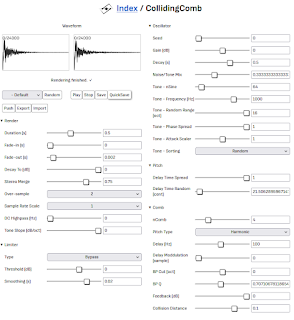Glitch Sprinkler is an album characterized by fast, high, and slightly out-of-tune synthesizer phrases. Throughout the album, a high-pitched alarm-clock-like sound keeps ringing, but for some reason I find myself feeling sleepy while listening to it.
The track titles are either cut up from random web pages, or some random terms that came up on my head. Below is a copy of lengthy flavor text on Bandcamp page.
---
This album mainly uses web synthesizers GlitchSprinkler and IntegerArpeggio. The characteristic of these two synthesizers is integer sample period, that is the length of a waveform doesn't have fractional part when represented in samples. A nice thing about this integer sample period is that the aliasing overtones added by some distortions will overlap to the frequencies of a original waveform. For example, the melody that starts at 0:15 in Sendung is mostly happened by aliasing of an overdrive.
That said, most of the tracks in this album aren't using integer sample period because of the use of pitch correction ("Stretch" option in FL Studio Sampler) to compose some chords. Also, integer sample period has a huge downside: it becomes increasingly out-of-tune at higher pitches. This out-of-tune effect is quite noticeable, so it's not that useful unless you are making strange music like this album. You can listen how out-of-tune it is in the track Undefined.
Below is a list of other subtle experimentations:
- 187.5 BPM is used as the tempo of many tracks. `(sampling rate in Hz) / (arbitrary period in samples) -> 48000 / 256 = 187.5`.
- 768000Hz is a track featuring GenericDrum.
- The bass at the middle of 4x oversampling is made from high-passed impulse, which I think suitable for fast 16 beat.
- Cumulonimbus is an improvisation, but the rhythm is quantized.
- No vocals is featuring 5 equal temperament.
- Recobbled, Rethieved, and Sad time aren't using GlitchSprinkler nor IntegerArpeggio. Their textures are different because of this.
---
Glitch Sprinkler は、速く、高く、ややチューニングの狂ったシンセサイザのフレーズが特徴的なアルバムです。アルバムを通して目覚まし時計のような高い音が鳴り続けるのですが、聞いているとなぜか眠くなってきます。
曲名は適当な web ページからのカットアップか、頭に浮かんだ適当な単語です。以下は Bandcamp に掲載している長々としたフレーバーテキストです。
---
このアルバムでは web シンセサイザの GlitchSprinkler と IntegerArpeggio を主に使っています。この 2 つのシンセサイザは波形の周期が常に整数サンプルになることが特徴で、歪みなどで倍音が付加されてもエイリアシングした成分が元の周波数成分と重なることで独特の響きが出ます。例えば Sendung の 0:15 から入るメロディーはほとんどオーバードライブのエイリアシングによるものです。
とは言ったものの、フレーズを平行移動するためにピッチ補正 (FL の Sampler の Stretch) を使ったことで、周期が整数サンプルになっていない曲がほとんどです。また、周期を整数サンプルにそろえると高い音程のチューニングが大きくずれてしまうという欠点があります。このチューニングのずれは Undefined で聞くことができます。
以下、その他の細かい点です。
- テンポが 187.5 の曲が多数あります。 187.5 という値は、サンプリング周波数の 48000 Hz を 256 サンプルで割った値です。
- 768000Hz のドラムは、サブベース以外 web シンセ版の GenericDrum を使っています。
- 4x oversampling の序盤のベースは、速い 16 ビートを強調するためにインパルスにハイパスをかけた音を使っています。
- Cumulonimbus は即興をクオンタイズしただけの曲です。
- No vocals の冒頭は 5 平均律です。
- Recobbled, Rethieved, Sad time は GlitchSprinkler と IntegerArpeggio を使っていないので、他の曲とは質感が異なっています。



















